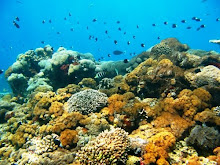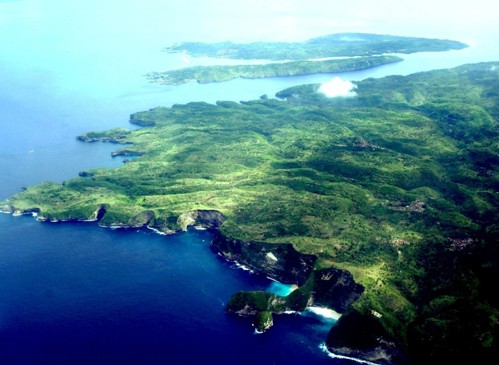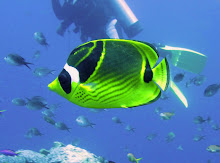The waves continued to rise towards the sky during what seemed to be an eternity, before crashing down to breaking and rolling towards shore. It seemed improbable that the army of speed boats wouldn’t be crushed and crumpled and tossed away. We piled in, with the dive gear apparently secured as the little speed boat began to bounce across the water. The captain was an expert, driving out to the Penida islands every day during the high season from June to December. He expertly negotiated the little boat towards an invisible break in the reef which created a channel from the six meter waves.
We were searching for Mola mola’s - the world’s heaviest and largest bony fish . Weighing in at a record 2500 kg and with an average width and length of two meters the fish use the currents as a system of public transport to allow them to effortlessly travel around the oceans. Mola mola is latin for ‘millet stone’ depicting the grey round flat shape which the fish embody. Their common names range from ‘sunfish’ (as they enjoy to float to the surface ‘thermally recharging’ in the sun), to ‘moonfish’ (in reference of their moon like shape and colour) to ‘swimming head’ (creating misleading images of monster fish heads swimming around the ocean). Without a true tail fin and with huge dorsal and anal fins which they flap from side to side, they are not the most aquadynamic of fish, which is why they tend to surrender to the currents, floating after their prey of jellyfish. Despite spreading across the oceans, and despite not being as tasty as other endangered marine life such as the severely threatened marlin and sharks, Mola mola sightings are uncommon. Their enormous size and bizarre shape are a huge attraction for recreational divers, and this is one of the reasons why I was bouncing around the back of a speed boat. The sea was a chilly 23 degrees Celcius, the current was strong and the Mola mola’s otherwise entertained. However, it is now officially Mola mola season in Bali and business is booming as divers fight the currents and the cold in search of an encounter.
The Penidas (which consists of three islands called Penida, Lembongan and Ceningan) is a major hotspot for diving, not just because of the ‘swimming heads’, but it also has at least 247 species of coral reefs and 562 species of reef fishes. This incredibly rich diversity is a hint of its proximity to ‘the amazon of the sea’. Extending north from the eastern tip of Bali up to the corner of Malaysia and the Philippines to Papua New Guinea, the Solomon Islands and East Timor, the ‘Coral Triangle’ covers a total area of 5.7 million square kilometers. Its sheer size and richness endows it as one of the world’s largest and most bio-diverse marine centres.
The headquarters for the The Nature Conservancy’s (TNC) Coral Triangle Centre is located in Nusa Penida, using the area as a base to run pilot projects, conduct marine studies and coastal community education. TNC reports that the Coral Triangle is home to over 600 reef-building coral species, which represents about 75 percent of all the species known to science. The area provides food to more than 3,000 species of reef fish which in turn has provided sustenance to hundreds of coastal communities for centuries. It serves as a vital spawning ground for economically important fish which then populate the surrounding waters. The archipelago acts as a migratory bottle neck as the strait between the Indian and Pacific Ocean brings together waters from the Lesser Sundas, Banda Sea and Papua marine eco-regions. The vigorous currents pump larvae through the waters circulating nutrient rich waters while providing an interconnecting link between the reefs. This is a clue to why Mola Molas are only a few of the rare large marine life which inhabit Indonesia’s seas.
The wonderfully fertile water provides food for large marine life also including whales dolphins, dugongs, manta rays, sharks and turtles, as they travel to their breeding areas with new species still being identified. For example, a new species of whale known to science, named a pygmy Bryde’s whale, was recently found in Komodo National Park. While, in March 2009, the world’s smallest ever whale shark was rescued in the Philippine province of Sorsogon. According to the WWF, its tiny size of 38 centimeters suggests that it was probably born in Philippine waters, at the apex of the Coral Triangle. Ironically, as new methods including DNA sampling are being developed to discover what lives beneath the seas, the numbers of marine mammals, fish and corals are being depleted at rapidly alarming rates. One potential way to reduce the pressure on the coral reefs and its fish populations is to reduce the fishing industry by finding alternative sources of income for the coastal communities.
During the illusive search for the Mola molas, it would have been far more rewarding to hunt for Eucheuma cottonni: A huge area between the shore and reef was covered in this species of farmed seaweed. The total production in the Nusa Penida sub-district is around 30 tons per 35 day (the period of the harvest) selling at a price of between IDR 2800/kilogram and IDR 5000/kilogram , and with large international markets in China, Japan and Taiwan, this makes it an incredibly profitable industry. Seaweed farming has been well established in Bali since the 1980s but it is only in recent years that the industry has boomed. The lucrative potential of seaweed farming suggested that it could be effective in reducing the pressure of over-saturation of the local fisheries, helping to alleviate overfishing and the subsequent low economic returns. However subsequent research showed the diversification of employment to include women and children in seaweed planting and harvesting rather than a shift in employment away from the fisheries. The benefits for the coral reef are not so clear. The reef acts as a natural protection for the seaweed farms from strong waves, but many times seaweed farms have been set up on top of the coral reefs or adjacent to reefs which can have ecological impacts due to shading of corals. Seaweed farms can also cause changes in patterns of sedimentation and water movement, erosion, depletion of nutrients and alteration of natural habitat prior to planting. Traditionally, the reefs belong to the village, making it difficult for farms to be owned by those from outside. Any disputes would be handled by the village chief. Consequently, many of the seaweed farms are owned by village cooperatives, but the question now is how these cooperatives can be used to protect the coral reefs?
TNC is currently working with the residents of Nusa Penida, Klungkung District Government, NGOs, universities and private sectors to create an effective Marine Protected Area (MPA) with the aim to be effective by June 2010. Complementary to the provision of community education on how to most effectively protect the reef, the MPA will also outline restrictions on fishing and regulations on fishing methods. The aim is that this will help to address imminent threats to coastal and marine ecosystems while supporting the sustainable use of marine resources stressing the importance of conservation. In the past dynamite blasting and trawling were common fishing methods which not only killed fish indiscriminately, with a large by-catch, but are incredibly destructive to the reef. The hope is that healthy fish stocks in a new MPA will replenish surrounding fishing grounds with eggs, larvae, and adult fish, while supporting a recent push for a more environmentally friendly tourism. This is particularly important during a time when tourists are flocking underwater. The challenge is how to use recreational sports such as snorkelling and scuba diving to decrease the pressure on the coral reefs, increasing the economic value of ‘live’ wild fish, keeping marine life in the ocean and out of the hotel buffets. The construction of mooring buoys has already been effective at addressing the problem of diving and snorkelling boats from dropping their anchors on the corals. Solid waste such as plastic bottles are perceived as one of the most serious environmental concerns threatening the Penidas. Coastal clean-ups are one way to start to try and reverse the damage of discarded rubbish but there is also a real need for a more sustainable and eco-logically friendly tourism.
Effective management of coastal resources and properly planned coastal development is absolutely essential to ensure that the coastal communities can remain reasonably intact and the coral reefs as resilient and healthy as possible. The importance of coral reefs in the global eco-system is often understated. “Out of sight – out of mind”; for those who don’t scuba dive, or live next to a reef, it is easier to view the reefs as a resource rather than protectors of the shores, nursery and feeding ground for fish and a vital part of the habitat for large and increasingly rare marine life, including Bali’s underwater star - the Mola mola.Many thanks to the scientists and conservationists at The Nature Conservancy for their assistance.
For more information on TNC and their continued work to protect Bali’s seas visit
http://www.nature.org/wherewework/asiapacific/indonesia/ and http://www.coraltrianglecenter.org/Be Active! TNC’s 10 easy things you can do to protect Bali’s Seas: http://www.nature.org/joinanddonate/rescuereef/explore/help.html
Copyright © 2010 Bali AdvertiserYou can read all past articles ofBA Feature Article at www.BaliAdvertiser.biz
 Sebagai salah satu upaya dalam mendukung pembentukan Kawasan Konservasi Perairan (KKP) di Nusa Penida, di awal Pebruari 2010, Peneliti Marine Conservation BROK, E. Elvan Ampou, M.Sc., melaksanakan temperature logger deployment di Nusa Penida.Deployment dilaksanakan sebagai implementasi kerjasama BROK dengan The Nature Concervancy (TNC).
Sebagai salah satu upaya dalam mendukung pembentukan Kawasan Konservasi Perairan (KKP) di Nusa Penida, di awal Pebruari 2010, Peneliti Marine Conservation BROK, E. Elvan Ampou, M.Sc., melaksanakan temperature logger deployment di Nusa Penida.Deployment dilaksanakan sebagai implementasi kerjasama BROK dengan The Nature Concervancy (TNC).









